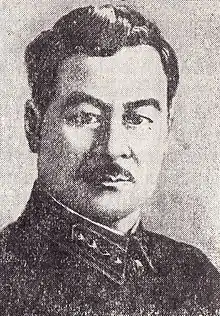Magaza Masanchi | |
|---|---|
 | |
| Born | 27 July 1886 Alma-Ata, Russian Empire |
| Died | 3 March 1938 (aged 51) Russian SFSR, Soviet Union |
| Allegiance | |
| Unit | Dungan Cavalry Regiment |
| Commands held | Commander of the Dungan Cavalry Regiment |
| Battles/wars | Russian Civil War |
| Magaza Masanchi | |||||||||||
|---|---|---|---|---|---|---|---|---|---|---|---|
| Traditional Chinese | 馬三奇 | ||||||||||
| Simplified Chinese | 马三奇 | ||||||||||
| |||||||||||
| Magaza Masanchin | |||||||||||
| Traditional Chinese | 馬三成 | ||||||||||
| Simplified Chinese | 马三成 | ||||||||||
| |||||||||||
Magaza Masanchi (27 July 1886 – 3 March 1937; Cyrillic Dungan: Магәзы Масанчын), Magaza Masanchin (Cyrillic Dungan: Магәзы Масанчын), or Ma Sanqi (Chinese: 馬三奇), was a Dungan communist revolutionary commander and Statesman in the Soviet Union.[1] He participated in the Russian Revolution on the Bolshevik side. Karakunuz in Kazakhstan was renamed Masanchi after him. He was a victim of the Great Purge by Joseph Stalin.
Career
Masanchi was born in Alma-Ata and his father was a farmworker.[2][1]
During the Russian Civil War the Bolsheviks were interested in seeking the support of the non Russian Central Asian peoples. Dungans were invited to join the Red Army.[3]
Dungans residing in town joined the Red Army after serving in the Tsarist forces when going back to Pishpek, fighting for the Soviets in Semirech'ye. However, Dungan peasants were apathetic to both sides in the Civil War, it was reported that the Bolsheviks committed atrocities against the indigenous inhabitants of Central Asia. On the side of the White Russians were Rich Dungans and the Islamic Dungan clerics.[4]
Masanchi originally took part in World War I as a member of the Russian Imperial Army. After the Tsar was overthrown he went to Tashkent.[1]
Masanchi commanded the Dungan Cavalry Regiment of the Red Army and was distinguished for his fighting against counter revolutionaries in Kazakhstan.[5][6] Magaza Masanchi fought for the Soviet Union with Dmitry Furmanov.[7] He became an official in Uzbekistan and Kazakhstan after the Civil War.[5]
After going to the 1921 Third Congress of the Comintern Masanchi battled the Basmachi movement. He was also a member of the Soviet secret police.[1]
Masanchi was a victim of the Stalinist Great Purge.[2] He was rehabilitated later.[5]
References
- 1 2 3 4 Joseph L. Wieczynski (1994). The Modern encyclopedia of Russian and Soviet history, Volume 21. Academic International Press. p. 125. ISBN 978-0-87569-064-3.
- 1 2 Borys Lewytzkyj (1974). The Stalinist terror in the thirties: documentation from the Soviet press. Hoover Institution Press. p. 493. ISBN 978-0-8179-1261-1.
- ↑ Central Asian Research Centre (London, England), St. Antony's College (University of Oxford). Soviet Affairs Study Group (1968). Situating Central Asian review, Volume 16. Published by the Central Asian Research Centre in association with the Soviet Affairs Study Group, St. Antony's College, Oxford. p. 251.
{{cite book}}: CS1 maint: multiple names: authors list (link) - ↑ Central Asian Research Centre (London, England), St. Antony's College (University of Oxford). Soviet Affairs Study Group (1968). Situating Central Asian review, Volume 16. Published by the Central Asian Research Centre in association with the Soviet Affairs Study Group, St. Antony's College, Oxford. p. 251.
{{cite book}}: CS1 maint: multiple names: authors list (link) - 1 2 3 Central Asian Research Centre (London, England), St. Antony's College (University of Oxford). Soviet Affairs Study Group (1968). Situating Central Asian review, Volume 16. Published by the Central Asian Research Centre in association with the Soviet Affairs Study Group, St. Antony's College, Oxford. p. 250.
{{cite book}}: CS1 maint: multiple names: authors list (link) - ↑ Rais Abdulkhakovich Tuzmukhamedov (1973). How the national question was solved in Soviet Central Asia (a reply to falsifiers). Progress Publishers. p. 74. ISBN 978-0-8285-0272-6.
- ↑ Joint Committee on Slavic Studies, American Council of Learned Societies, Social Science Research Council (U.S.), American Association for the Advancement of Slavic Studies (1968). The Current digest of the Soviet press, Volume 20. American Association for the Advancement of Slavic Studies. p. 35.
{{cite book}}: CS1 maint: multiple names: authors list (link)